Understanding the NFT Valuation Framework CACAU: Approaching from Culture, Aesthetics, Community, Assets, and Utility
Written by: 0xPrismatic, Delphi Digital
Compiled by: Alex, TechFlow
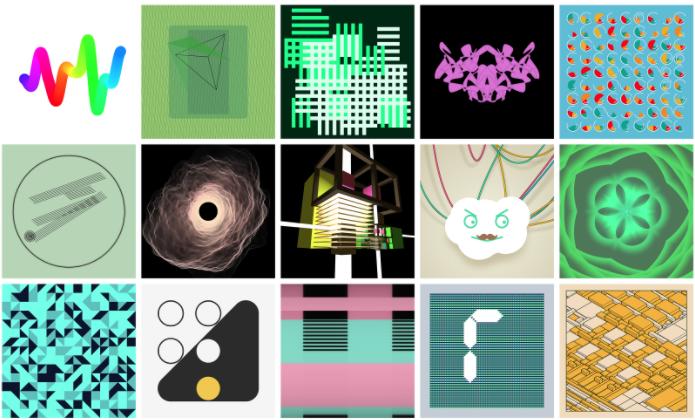
The gathering of art blocks, Source: Sotheby's
2021 marked the rise of NFTs—what a wonderful year it was! In this short span of a year, we witnessed explosive growth in artistic creativity, technological innovation, and capital inflow in this space.
I am thrilled to see many developers, innovators, and artists experimenting with this technology as a new medium for their creations. Every project that utilizes NFTs in interesting new ways sends shivers down my spine.
One key factor driving this rapid growth is that NFTs enable the financialization of global culture. Culture is a reflection of our daily lives. NFTs have a relatively low barrier to entry for ordinary people, unlike DeFi, which requires a minimum level of technical and financial knowledge. Buying an axis to play a card battle game similar to "Pokemon" is 100 times more intuitive than purchasing and depositing USDC into a Curve pool to create governance tokens.
An increasing number of mainstream celebrities like Jay-Z, Snoop Dogg, Stephen Curry, Paris Hilton, and Steve Aoki have adopted NFTs as their digital identity, igniting the desire for imitation among millions of fans, further propelling this trend.
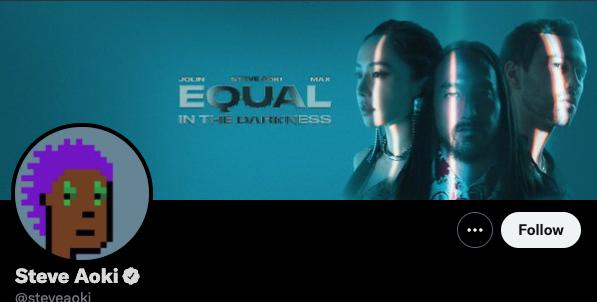
Steve Aoki loves his CryptoPunks
NFT Frenzy
In the past few months, we have witnessed a lot of speculation, with some NFT prices skyrocketing 10 to 100 times within weeks and then plummeting by 90%.
The reasons for the huge volatility in NFT prices and their difficulty in valuation are:
1) The liquidity of NFTs is relatively poor. Transactions occurring at the margin can rapidly change the floor price.
2) Due to limited price history, it is in a constant state of price discovery.
3) Many intrinsic values of NFTs (such as culture) are intangible and difficult to quantify.
4) There is no consistent valuation framework.
5) NFTs are highly narrative-driven. (This is the most important point, which I will elaborate on later)
The first NFT I purchased was a Non-Fungible Ape in January 2021, a pixel art that metaphorically represented various characters as "apes." I stumbled upon their first invisible airdrop on Discord, but I didn't know what I was doing at the time. Browsing through every image on OpenSea ignited a strong desire in me to buy and collect apes with the rarest traits. Today, their value is 0: there are no buyers. This experience gave me a profound lesson.
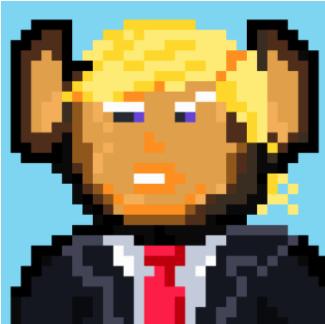
Donald Trump Non-Fungible Ape, a rare ape worth 0.7E
In hindsight, I should have anticipated this, as the market was entirely sustained by speculation: it had no historical value, was created by an anonymous artist who had just joined Twitter, belonged to a small community, had zero utility, and featured mediocre art. It attempted to create a narrative in any of the 5 NFT domains I will outline later but failed to succeed.
However, the prices of other NFTs have soared to dazzling heights. A CryptoPunk that was purchased for just $35 in 2017 could now be worth up to $9.5 million.
Look at Board Ape Yacht Club, Fidenzas, XCOPY, mystic axies, and so on. What makes them so valuable now, and how can we identify these value opportunities in NFTs early?

No wonder we are all asking 'wen next fidenza'?
Why Are NFTs Different?
I am fascinated by NFTs because they inherently represent a unique layer of complexity that fungible tokens do not have. This layer includes both intangible (e.g., culture) and tangible aspects, making it an interesting intellectual exercise.
At the highest level, NFTs exist and share the same foundational layer as all other crypto applications, which is the blockchain infrastructure, with Ethereum being the most commonly used blockchain. This includes application-specific chains and L2 solutions for NFTs, such as Flow and Immutable X.
The next layer—the platform layer—provides financial services for NFTs: think of exchanges, liquidity provision, lending, decentralization, etc. These are platforms because they typically serve multiple different tokens rather than a single token.
Unlike fungible tokens, NFTs have another layer where a single "application" is packaged into the token itself. The NFT standard (usually ERC-721) allows the token to link to on-chain or off-chain assets through its metadata while retaining the provenance, immutability, and network security of the blockchain.
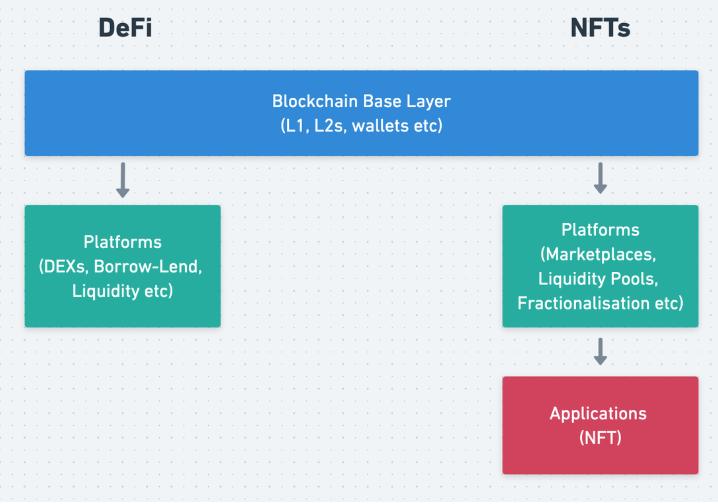
Let me simplify this with a Web2 analogy:
(Level 1) Underlying Blockchain = Internet + Mobile.
For example: TCP/IP, iPhone. Broadly and publicly available.
(Level 2) Applications/Infrastructure = Internet Platforms.
For example: Apple's App Store.
(Level 3) NFTs = Individual Mobile Applications.
For example: Facebook app.
Platforms are very powerful and derive immense value through their network effects and broad market coverage. Good platforms require a significant amount of time to build, grow, and achieve rapid growth on the adoption curve. Individual applications typically represent a layer with the highest levels of diversity, innovation, and creative input—because now anyone with an idea can relatively easily create and launch a (basic) mobile application. The Web3 equivalent here is NFTs.
To further illustrate this, let’s consider Aave (platform) and CryptoPunks (NFT):
The value of AAVE is closely tied to the success of the entire Aave application/protocol: the total value locked primarily includes various LP tokens, generated revenue, and user growth.
The value of a CryptoPunk is… how cool it looks, how rare it is, and how many people actually want it. It does not rely on any external applications.
A Simple Ontological Framework for NFTs
So I began to explore a framework for thinking about NFTs:
1) How do you identify NFTs with narratives that could spread?
2) How do you determine if an NFT is undervalued or overvalued?
The purpose of this is not to quantify a specific fair value for NFTs—NFTs do not have discounted cash flow models. Instead, I have developed a dynamic framework for NFT project creators and NFT investors to make better decisions.
I delved into the factors that give NFTs value and distilled them into 5 main domains. This differs from the typical classifications of NFTs we are all familiar with: collectibles, generative art, virtual land, gaming, etc. The reason is that there is often significant overlap between these categories. These 5 domains apply to all NFTs, although their relative importance varies by project.
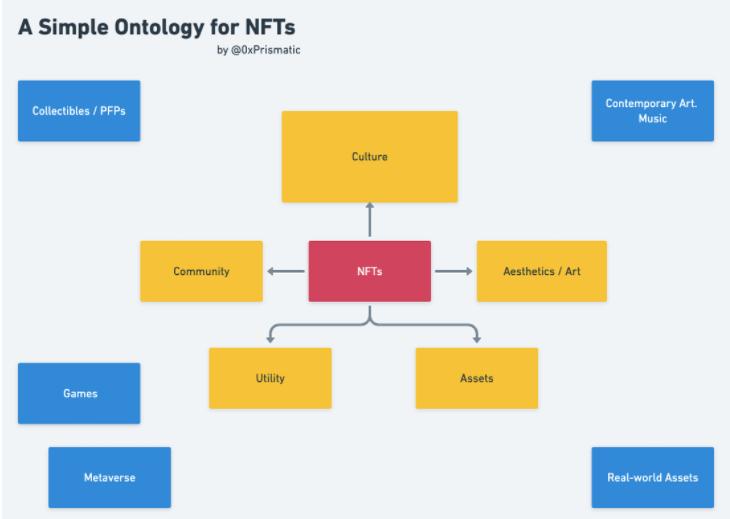
Compared to fungible counterparts, NFTs have cultural and aesthetic advantages. Ranging from the intangible to the tangible, these 5 domains are:
1. Culture (Intangible)
1) This is the most interesting part of NFTs and also the hardest to value.
2) Culture is broad, encompassing the shared experiences, views, and beliefs of a society.
3) Cultural components include but are not limited to:
- Brand value
- Historical significance
- Desire to imitate: We desire the desires of others because we mimic their desires
- Status value: Am I seen as showcasing wealth, culture, and class?
2. Aesthetics (Intangible)
1) Refers to the aesthetic appeal of the media associated with the NFT (e.g., artwork, music)
2) Do you like it? How many others, especially trendsetters, like it?
3) Does ownership indicate that you have a good insight into beauty?
3. Community (Tangible - Intangible)
1) Refers to the totality of existing owners of the NFT collection
2) As with most things in Web3, community is everything.
3) What are the demographics, psychographics, wealth, and vision of the owners? Are they more likely to be diamond hands or paper hands? Are they loud and brash, or quiet and sophisticated?
4) Measurable metrics: Is the community growing, stagnating, or declining? How many contributors are there?
4. Utility (Tangible)
1) Refers to the benefits derived directly from owning the NFT, such as private membership groups, early access to mints, token farming, physical goods
2) A major component of gaming and Metaverse NFTs: for example, Axies, Sandbox Land, Star Atlas spaceships, Ember sword badges. These can also generate income in play-to-earn games.
3) NFTfi (NFT + DeFi) is very interesting.
5. Assets (Tangible)
1) Refers to the digital or real-world assets that NFT owners have rights to, aside from the NFT itself
2) For example: project treasury, other NFTs, intellectual property, real estate
In the upcoming articles, I will delve deeper into each of these 5 domains with examples.
In summary, NFT = Culture + Aesthetics + Community + Assets + Utility
(NFT = Culture + Aesthetics + Community + Assets + Utility, CACAU)
This is a summation (+) equation: this means that all NFT projects intending to maximize their value and become investable assets should consider their performance in each of these 5 domains, even if they may only focus on one area.
Example:
A generative artist with the ability to create algorithms for amazing artworks that the world needs should also consider:
How he/she interacts with collectors and builds a positive community instead of completely disappearing "for my art work."
How he/she can increase the utility of owning the artwork through memberships, early access to new works, etc.
While aesthetics is the primary domain here. Aesthetics may be hard to judge, but community and utility are easier to measure.
Notes
Several blockchain-related factors are not captured in this framework but may contribute to the narrative and value of NFTs:
1. The Underlying Chain of NFTs
Ethereum is currently the preferred network for NFTs, especially high-value NFTs. This is partly due to the security assurances of the network.
NFTs on chains outside of Ethereum or on L2 Rollups (e.g., Polygon, Solana, Avax, Arbitrum) are significantly discounted in today's market, although this may not be the case in the future.
2. The Persistence of Underlying Data
Arweave > IPFS > Centralized Websites
3. (Gen Art) On-chain vs Off-chain
Art stored entirely on-chain seems to have an advantage over art stored in off-chain locations. Blockchain space is very expensive, making on-chain storage often impractical.
For example, Autoglyphs as the oldest on-chain generative art project.
4. Derivatives vs Originals
Successful projects will be cloned and forked multiple times, which is a rule of crypto. As we have seen multiple times, due to speculation, the prices of derivatives may spike sharply in the short term, but in the long run, values usually revert to their original levels.
For example, Cryptopunks ← Phunks, Fast Food Punks, Picasso Punks, Bastard Gan Punks……
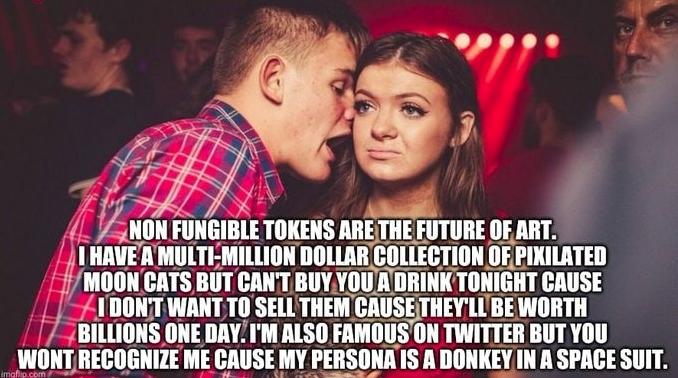
Conclusion
Why bother with this? Shouldn't NFTs be simple: just buy what I like? Yes, that works too.
I put this framework together to help me better understand and systematically identify the factors that can drive NFT value. And to avoid FOMO on projects with weak narratives or temporariness. I hope it is useful to you as well.
I believe that for NFTs to become a truly investable asset class, we need to start thinking and using the same language as people in the traditional investment world. A framework that non-crypto natives can understand and unveil the mysteries of crypto technologies and concepts.
A value investing approach would be:
1) In the context of NFTs, what is culture?
2) How do we identify substantive cultural narratives that need attention?
3) Can we assign value to the different components of culture?
4) How do artists (original artists, photographers, musicians, etc.) price their work?
5) CryptoPunks vs Bored Apes: a case study.










